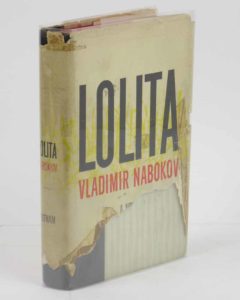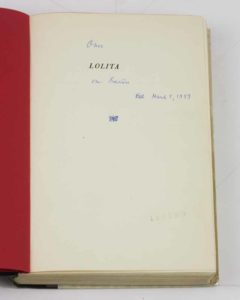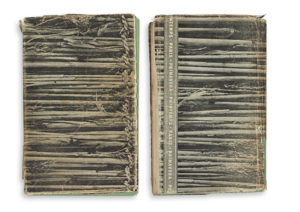
Allison Janney as Margaret Scully reading Lolita in Masters of Sex.
It is St. Louis, 1958. A woman, middle-aged, married, upper-middle class, is in bed, reading. Her husband walks in. She puts the book aside. The book is Lolita. This is a shot from the first episode, “Parallax”, of the new, second, season of Showtime’s Masters of Sex, 25:48 in.
The shot is slightly odd, though. It is clear that the Lolita is a thick, single, hardbound volume in the green Olympia Press dust jacket. Only one Lolita matches that description: The single-volume hardcover issued by Steimatzky in Israel most probably in 1959 (A28.1, Israeli printing, variant a). So, why is the woman, Allison Janney as Margaret Scully, a university provost’s wife in 1958, reading a foreign edition of a book that was released in the U.S. by Putnam on 15 September 1958? How did she get a hold of it a year before it was issued? Did someone send it to her from Israel? Had she recently visited Israel? Is there a backstory here?
Probably not. The only backstory that makes sense is one that the show’s prop master would tell us. Take a close look at the still from the episode. The jacket is in remarkably good shape. Makes sense for 1958 or 1959. But not for today, 55 years later, for a prop master to have found a dj in such fine condition. Also, that dj has some small, illegible printing in the lower left-hand corner of its back cover. A real Steimatzky dj is blank on its back. So it’s not a real Steimatzky dj.
Another detail. The top of the hardcover binding peeking out from the top of the dj reveals a volume quarter-bound in black cloth and white paper. Ah, that’s the Putnam edition. So, what we have is a marriage of an almost Steimatzky dj with a Putnam hardbound binding. The prop master seems to have scrambled to come up with the prop that the script called for. He found a Putnam copy, but without the dj. He needed a dj so that the camera could pick up the title easily. (There is no title or other writing on the Putnam binding.) Somewhere he found a copy or photo of one of the Olympia Press issues, covers and spine, and had a facsimile dj made to fit the slightly larger Putnam binding. But I still can’t figure out what that writing is on the bottom-left of the back cover.
So much for nitpicking popular period-piece television.





Recent Comments